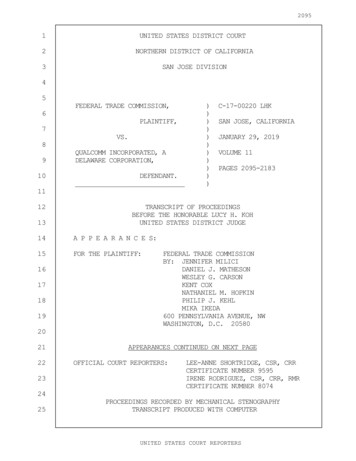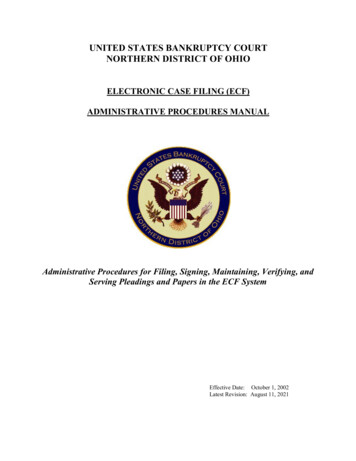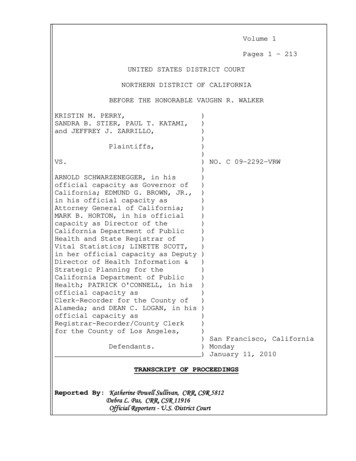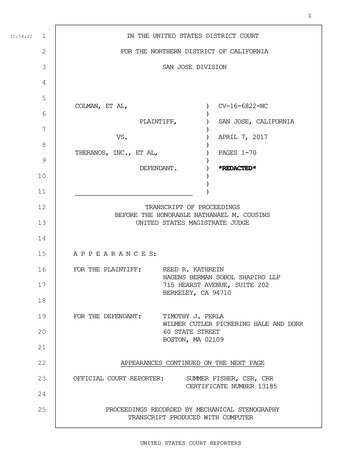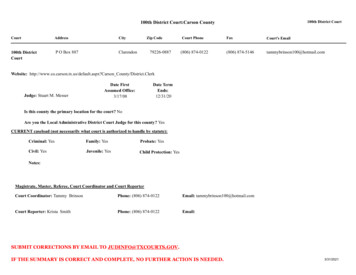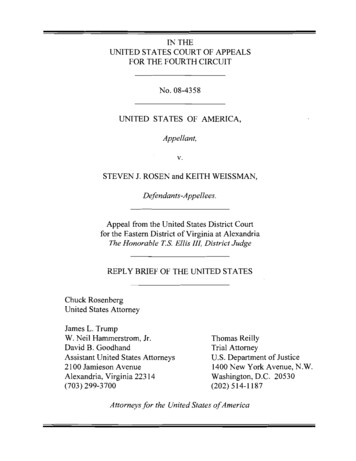
Transcription
SHEVLIN et al v. THE PHOENIX LIFE INSURANCE COMPANY et alDoc. 174UNITED STATES DISTRICT COURTDISTRICT OF NEW JERSEYBRIAN S. SHEVLIN, et al.,CIVIL ACTION NO. 09-6323 (MLC)Plaintiffs,MEMORANDUM OPINIONv.PHOENIX LIFE INSURANCE COMPANY,et al.,Defendants.COOPER, District JudgePlaintiffs, Brian S. Shevlin, Keith P. Shevlin, and Erin R. Taylor (collectively“Plaintiffs”), brought this suit against Defendants, Phoenix Life Insurance Company(“PLIC”) and Phoenix Companies, Inc. (“PNX” and collectively “Defendants”), alleging,inter alia, breach of contract and unjust enrichment following the demutualization ofPLIC’s predecessor, Phoenix Home Life Mutual Insurance Company (“Phoenix Home”).Defendants have moved for summary judgment. (See dkt. entry no. 136, Notice of Mot.)For the reasons that follow, that motion will be denied in its entirety.I. BACKGROUNDThe undisputed facts, as developed through discovery, are as follows. Prior to 2001,Phoenix Home was a mutual life insurance company. A distinctive feature of mutual lifeinsurance companies is that they are owned by their policyholders. Mutual life insurancecompanies do not have stockholders. (Dkt. entry no. 137, Reid Decl., Ex. 11, Expert ReportDockets.Justia.com
of Edward W. Buttner IV (“Buttner Report”) at 5.) Plaintiffs were insured by Phoenix Homepursuant to life insurance policies purchased in 1991 in New Jersey by their father. (SMUF at¶ 120.)1 Plaintiffs were eligible to receive dividends under the terms of these policies asapportioned each year by the Board of Directors of Phoenix Home in its discretion. (Id. at ¶121.)In 2000, Phoenix Home began to formulate a plan to convert from a mutualcompany to a stock company. (Id. at ¶ 8.) In December 2000 and January 2001, PhoenixHome’s Board of Directors unanimously adopted a Plan of Reorganization (“the Plan”).(Id. at ¶ 9.) In February 2001, Phoenix Home notified all of its policyholders as ofDecember 18, 2000 about a public hearing and policyholder vote on the Plan. (Id. at ¶10.) The policyholders were sent an Information Booklet, which contained the Plan aswell as financial information about Phoenix Home. (Id. at ¶ 11.)The materials explained to the policyholders that Phoenix Home would berenamed PLIC following the demutualization and that PLIC “would establish anaccounting mechanism called the Closed Block.” (Id. at ¶ 13.) A Closed Block is aregulatory mechanism that “is intended to address the natural tension that arises after thedemutualization between participating policyholders” and shareholders and “to preventmanagement from reducing policyholder dividends for the purpose of benefitingshareholders” — in this case, PNX, PLIC’s parent company and sole shareholder. (See“SMUF” refers to Defendants’ Statement of Material Undisputed Facts (dkt. entry no. 140)and Plaintiffs’ response thereto (dkt. entry no. 144-2).12
Reid Decl., Ex. 9, Expert Report of J. Peter Duran (“Duran Report”) at 8; see also ButtnerReport at 5; SMDF at ¶¶ 2, 8.)2 PLIC informed the policyholders that “assets allocated tothe Closed Block” and “cash flows in excess of amounts assumed” would only beavailable for distribution to policyholders in the form of benefits or dividends; the ClosedBlock assets and income generated from those assets would not “be available to [PLIC’s]stockholders.” (SMUF at ¶ 16; Reid Decl., Ex. 1B, Information Booklet, Part II at 75.)PLIC also advised its policyholders that the objective behind the Closed Block isto “ensure that the reasonable dividend expectations of policyholders . . . will be met.”(SMUF at ¶ 14.) “Reasonable dividend expectations” is defined in the ActuarialStandards of Practice (“ASOP”) 33 as “[t]he expectations that the current dividend scalewill be maintained if the experience underlying the current scale continues, and that thedividend scale will be adjusted appropriately if the experience changes.” (Id. at ¶ 15(quoting Reid Decl. Ex. 27, ASOP 33 at ¶ 2.7).)3 Plaintiffs’ expert J. Peter Duran(“Duran”) explains that “[s]atisfying the reasonable dividend expectations of closed blockpolicyholders is especially important because as part of the demutualization, thesepolicyholders gave up their ownership interests in the mutual insurance company, relyingin part on management’s representations that policyholders’ interests, including their“SMDF” refers to Plaintiffs’ Statement of Material Disputed Facts (dkt. entry no. 144-1) andDefendants’ response thereto (dkt. entry no. 149-1).2The Information Booklet explained the meaning of “dividend scale”: “Experience-baseddividend scales are actuarial formulas used by life insurers to determine amounts payable as dividendson participating policies based on experience factors relating to, among other things, investmentresults, mortality, lapse rates, expenses, premium taxes and policy loan interest and utilization rates.”(Information Booklet, Part II at 76.)33
dividend interests, would be protected and preserved post-demutualization.” (DuranReport at 9.)Echoing ASOP 33, PLIC explained to policyholders that it would:allocate assets to the closed block in an amount that produces cash flowswhich, together with anticipated revenues from the closed block policies,are reasonably expected to be sufficient to support obligations andliabilities relating to these policies, including, but not limited to,provisions for payment of claims and certain expenses and taxes, and forcontinuation of policyholder dividend scales in effect for 2000, if theexperience underlying such scales continues, and for appropriateadjustments in such scales if the experience changes.(Information Booklet, Part II at 75.) The Information Booklet further provided:To the extent that, over time, cash flows from the assets allocated to theclosed block and claims and other experience relating to the closed blockare, in the aggregate, more or less favorable than assumed in establishingthe closed block, total dividends paid to closed block policyholders in thefuture may be greater than or less than the total dividends that would havebeen paid to these policyholders if the policyholder dividend scales ineffect for 2000 had been continued. Dividends . . . , as in the past, will bedeclared at the discretion of the [PLIC Board of Directors]. Thesedividends may vary from time to time, reflecting changes in investmentincome, mortality, persistency and other experience factors, and are notguaranteed.(Id. at 75-76.) PLIC notified policyholders that it would “set the dividends on the closedblock policies annually, in accordance with applicable law and consistent with theobjective of minimizing tontine effects and exhausting the assets of the closed block withthe final payment made to the holder of the last policy included in the closed block.” (Id.at 76; see also SMUF at ¶¶ 38, 39 (“ASOP 33 states that ‘[a]fter the closed block isestablished, the objective is to manage aggregate dividends so as to exhaust the assetswhen the last policy terminates, while avoiding the creation of a tontine’” and “‘the4
actuary should recommend a dividend scale that is consistent with [this] goal’” (quotingASOP 33 at ¶¶ 3.1, 3.6)).)4Following a public hearing, on April 2, 2001, 95% of the policyholders that votedapproved the Plan. (SMUF at ¶ 24.) The New York Superintendent of Insurance (“theSuperintendent”) approved the Plan on June 1, 2001. In approving the Plan, theSuperintendent specifically noted that “[d]ividends will be apportioned annually by[PLIC’s Board of Directors] in accordance with applicable law” and “dividends are notguaranteed.” (Id. at ¶ 27.) “On June 25, 2001, [Phoenix Home] converted from a mutuallife insurance company to a stock insurance company and [became] a direct, whollyowned subsidiary of [PNX], a publicly owned entity traded on the New York Stock“A tontine would be created if dividends were underpaid for an extended period of time,thereby allowing excess assets to accumulate within the closed block.” As a result, “persistingpolicyholders would receive a windfall, while policyholders who had terminated due to death or lapsewould receive less than their equitable share of dividends.” (Duran Report at 9 (citing ASOP 33).)45
Exchange and formed in conjunction with the demutualization.” (Buttner Report at 5; seealso SMUF at ¶ 28.)5Immediately following demutualization, with respect to calculating and declaringpolicyholder dividends, “PLIC assumed that the dividend scale that had been in effectsince January 1, 1999 would remain so, and that its underlying assumptions wouldAfter the demutualization, both PLIC’s policyholders and shareholders were eligible toreceive dividends, subject to certain limitations. The relationship between the Closed Block,policyholder dividends, and shareholder dividends is explained as follows by Plaintiffs’ expert,Edward W. Buttner IV (“Buttner”). “[T]he Closed Block assets, the cash flows generated by theClosed Block assets, and the anticipated revenues from the policies in the Closed Block can beused only for the benefit of the Closed Block policyholders, and may not inure to the benefit ofthe stockholders of PNX.” (Buttner Report at 7.) “The post-demutualization statutory operatingresults of the Closed Block are distributed to Closed Block policyholders in the form ofpolicyholder dividends and the net statutory earnings (after policyholder dividends) are includedin the statutory operations result of PLIC and impact the amounts that PLIC is permitted todistribute to PNX.” (Id. at 8-9.) “[T]he maximum amount of [Closed Block] earnings whichmay inure to PNX over the life of the Closed Block is defined by the excess of closed blockliabilities over closed block assets at the demutualization date,” which was 1.5 billion. (Id. at 910.) Upon the creation of the Closed Block, “[b]ecause the closed block liabilities exceed closedblock assets, PLIC maintained excess ‘residual’ assets and surplus (initially 1.5 billion) in itsgeneral account that supported the Closed Block.” (Id. at 11.) Over the life of the Closed Block,“[a]s Closed Block earnings are realized, and the excess of closed block liabilities over closedblock assets decreases, PLIC will reduce the residual assets and redeploy the related surplus forthe benefit of PNX.” (Id.)“[T]he assets and liabilities of the Closed Block are actually held within PLIC’s generalaccount,” and thus, the Closed Block needs to be accounted for in a manner that prevents excessearnings of the Closed Block from benefiting PNX. (Id. at 11-12.)5The actuarial model projection created at the inception of the Closed Block isintended to be used as the metric for comparing the actual cumulative earningsagainst the projected cumulative earnings at each reporting date, to ensure thatany excess earnings benefit only the Closed Block policyholders and arerecognized as a liability of PLIC known as the policyholder dividend obligation or“PDO,” so that PLIC’s shareholder does not receive the benefit of those earnings.(Id. at 11.) “A reduction in the PDO liability would increase [earnings calculated pursuant toGenerally Accepting Accounting Principles] which . . . would result in benefits to bothmanagement and stockholders.” (Id. at 23.) PDO liability can be decreased by changing theinitial projections for the life of the Closed Block, known as a “glidepath.” (See id.)6
remain unchanged.” (SMUF at ¶ 36.) Notably, prior to Phoenix Home’sdemutualization, certain policies, including Plaintiffs’, “had received an adjustment thatset their dividends at 75.8% of the 1994 dividend scale. When the Closed Block wasfunded, the 1999 scale had this adjustment embedded in it for those policies.” (Id.)Each year after the 2001 demutualization, PLIC’s Closed Block Actuary gavePLIC’s Policyholder Affairs Committee (“PAC”) of PLIC’s Board of Directors (“Board”)a presentation, which included a financial report for the Closed Block and arecommendation regarding the following year’s dividend actions, including whether toadjust the dividend scale. (Id. at ¶ 45.) The PAC would then present a recommendationto the Board regarding the Closed Block policyholder dividend scale, and the Boardwould vote on whether to maintain or change the dividend scale. (Id. at ¶ 46.) PLIC alsoengaged Towers Watson (formerly “Tillinghast” or “Towers Perrin”), an externalactuarial firm, to assist in the dividend scale reviews in the years following thedemutualization. (Id. at ¶¶ 52, 104.) 6After the Closed Block’s establishment in 2001, “PLIC maintained the operative1999 dividend scale for Closed Block policies for calendar years 2001, 2002, 2003, 2004,and 2005.” (Id. at ¶ 47.) However, in reports from 2003 and 2005, Towers Watsonexpressed views that the dividend scales would eventually need to be reduced to assureThis entity will be referred to “Towers Watson” throughout regardless of the entity’s name atthe time of the actions in question.67
that there were sufficient assets to cover liabilities in the Closed Block. (Id. at ¶¶ 106,107.)For the 2006 calendar year, PLIC, for the first time since demutualization,changed the dividend scale. In a June 14, 2005 memorandum, Vy Ho (“Ho”), the ClosedBlock Actuary during the 2006 dividend scale review, concluded “that (i) the aggregateperformance as of December 31, 2004 of the Closed Block was positive, but (ii) thecurrent dividend scale would not be supportable because the downward trend in interestrates would soon overwhelm the positive experience with regard to mortality.” (Id. at ¶¶50, 53.)7 An August 18, 2005 presentation by Ho and his staff and consultants to thePAC “showed that unless the dividend scale were adjusted, the Closed Block was likelyto exhaust its assets in or around 2040, approximately 55 years before the likelytermination of the last policy in the Closed Block.” (Id. at ¶ 54.) And, in a November 3,2005 presentation to the PAC, Ho and his staff and consultants provided “updatedactuarial models for the Closed Block and recommended a dividend scale change thatinvolved adjusting both the interest and mortality factors in the formula used to calculatedividends.” (Id. at ¶ 56.) At the Board meeting on that same day, the PAC reported onthe recommended dividend scale change, and the Board adopted the recommendation.(Id. at ¶ 58.)87The 2006 dividend scale review was based on financial data through December 31, 2004.Year-end 2005 financial data was not available at the time. (See Buttner Report at 17.)Plaintiffs suggest that the PAC’s and Board’s approval was self-interested because “all of themembers of the [PAC] and the 13 Board of Directors of PLIC were shareholders of PNX,” PLIC’ssole shareholder. (Dkt. entry no. 144, Pls.’ Opp’n to Defs.’ Mot. for Summ. J. (“Pls.’ Opp’n”) at 30.)88
Based on the projections and calculations discussed above and following Boardapproval, PLIC implemented the change to the Closed Block dividend scale for the 2006calendar year “and determined the dividend payable to each policy in the Closed Block,by applying adjustments to interest and mortality components of the 1999 scale.” (Id. at¶ 59.) Towers Watson opined that the dividend scale reduction in 2006 was reasonable.(Id. at ¶ 108.) Plaintiffs’ experts Duran and Buttner disagree and assert that the dividendscale change in 2006 was two to four years premature. (Id. at ¶ 94.)The 2006 dividend scale change resulted in a 17% aggregate reduction, orapproximately 58 million, in the dividends allocated to most policies in the ClosedBlock. (Id. at ¶ 61; SMDF at ¶ 47; Duran Report at 39.) The reduction resulting fromthe 2006 scale change was even more significant in 2007 because PLIC used a practicecalled “pegging” for calculating the 2006 dividend. Pegging is a common practice in theindustry designed to transition to a new dividend scale and mitigate the effects of areduction. (SMUF at ¶ 87.) In calculating the 2006 dividend paid to policyholders, PLIC“‘pegged[]’ the 2006 dividend at 75% of the 2005 dividend.” (Id.) But in 2007, peggingwas no longer applied in calculating the dividend. (See id. at ¶ 88.)PLIC maintained the 2006 dividend scale in calendar years 2007 and 2008. (Id. at¶ 96.) PLIC again adjusted the Closed Block dividend scale for calendar year 2009,9
which resulted in an additional reduction in dividends for most policies in the ClosedBlock. (Id. at ¶ 97.)9During the life of the Closed Block, PLIC engaged Jack Gibson (“Gibson”) ofTowers Watson to serve as the Independent Actuary for PLIC’s Closed Block. (Id. at ¶100.) In this role, “Gibson was required to submit opinions every five years to the NewYork Department of Financial Services on whether PLIC, in establishing the ClosedBlock dividend scales for the preceding five-year period, ‘has acted in accordance with . . the Plan.’” (Id. at ¶ 101.) Gibson issued opinions in 2006 and 2011 in which heconcluded that the Closed Block dividend scales for each year through 2011 wereconsistent with the Plan and actuarial standards. (Id. at ¶¶ 60, 102, 110-11.)Following the 2006 dividend scale change, which reduced Closed Blockpolicyholder dividends, PLIC’s sole shareholder, its parent company PNX, receivedPlaintiffs state that they do “not challenge[] the 2009 dividend scale change because theoutcome of that challenge depends on the lawfulness of the 2006 change.” (Pls.’ Opp’n at 1 n.2.) Thesignificance of this statement was disputed by the parties at oral argument, specifically with regard towhether Plaintiffs waived claims to damages for the dividends declared in the years following 2008.(See dkt. entry no. 171, 6-12-14 Tr. at 13, 19, 103-04.) Given the resolution of this motion, the Courtneed not decide this issue at this juncture.910
greater aggregate dividends than it had in prior years.10 The following chart illustratesthe dividends distributed to PNX for calendar years 2003 to 2009:YearDividend2003 44.5 million2004 69.7 million2005 35.1 million2006 87.5 million2007 92.2 million2008 83.3 million2009 0(Id. at ¶¶ 112-18.) The members of the PAC and the Board were all shareholders ofPNX, which received those stockholder dividends. (See SMDF at ¶ 106.) Meanwhile,the individual policyholder dividends of Plaintiffs decreased from about 25 to 50before 2006 to between about 2 and 3. (SMUF at ¶¶ 124, 131, 137.)Plaintiffs’ Second Amended Complaint alleges three causes of action againstDefendants: (1) breach of contract; (2) violation of the New York Consumer ProtectionLaw; and (3) unjust enrichment. (Dkt. entry no. 23, Second Am. Compl. at 32-39.)10According to Plaintiffs, there is a relationship between the decreased dividends to ClosedBlock policyholders and the increased dividends to PNX as sole shareholder. As described by theirexpert, Buttner, the reduction in the Closed Block policyholder dividends ultimately freed residualassets. Briefly explained, the residual assets are held in PLIC’s general account to support the ClosedBlock at the time of funding, originally in the amount of the difference between the Closed Blockliabilities and assets at funding (because liabilities exceed assets at that point in time). As the ClosedBlock’s earnings increase and the liabilities decrease over time, PLIC does not need to hold as manyresidual assets in its general account to cover that difference. Therefore, a reduction in thepolicyholder dividend, a liability of PLIC, would allow PLIC to redeploy more of those residual assetsfor the benefit of its shareholder, PNX. (See Buttner Report at 8-12; Pls.’ Opp’n at 36.)11
Plaintiffs have since abandoned their claim under the New York Consumer ProtectionLaw. (See Pls.’ Opp’n at 39.) Defendants have moved for summary judgment. (See dkt.entry no. 136.) The Court held oral argument on June 12, 2014. (See dkt. entry no. 167.)II.SUMMARY JUDGMENT STANDARDMotions for summary judgment are governed by Rule 56, which provides that theCourt “shall grant summary judgment if the movant shows that there is no genuine dispute asto any material fact and the movant is entitled to judgment as a matter of law.” Fed.R.Civ.P.56(a). The movant has the initial burden of proving the absence of a genuinely disputedmaterial fact relative to the claims in question. Celotex Corp. v. Catrett, 477 U.S. 317, 323,331 (1986). Material facts are those “that could affect the outcome” of the proceeding, and “adispute about a material fact is ‘genuine’ if the evidence is sufficient to permit a reasonablejury to return a verdict for the non-moving party.” Lamont v. New Jersey, 637 F.3d 177, 181(3d Cir. 2011) (citing Anderson v. Liberty Lobby, Inc., 477 U.S. 242, 248 (1986); CelotexCorp., 477 U.S. at 322-23). Summary judgment is “proper if, viewing the record in the lightmost favorable to the non-moving party and drawing all inferences in that party’s favor, thereis no genuine issue of material fact and the moving party is entitled to judgment as a matter oflaw.” United States ex rel. Kosenske v. Carlisle HMA, Inc., 554 F.3d 88, 94 (3d Cir. 2009).III.LEGAL PRINCIPLESThe parties dispute whether the Court should apply breach-of-contract or corporategovernance principles in evaluating PLIC’s conduct. Defendants argue that the Court must beguided by corporate governance principles and give “deference to the Board’s determination12
that the 2006 adjustment was appropriate in managing the Closed Block and meetingreasonable dividend expectations, absent proof of bad faith, willful neglect, or abuse ofdiscretion.” (Dkt. entry no. 149, Defs.’ Reply Br. at 4.) Plaintiffs counter that, followingdemutualization, policyholders are no longer company owners. Instead, their relationshipwith the company is contractual and statutory, and, as such, deferential corporate governanceprinciples are inapplicable. (Pls.’ Opp’n at 28.)11The parties agree that New York law applies to their dispute. With respect to mutuallife insurance companies under New York law, when a policyholder challenges discretionarydecisions of the directors regarding the distribution of a surplus, the courts, analogizing thesituation to that of stock ownership, have stated that they “will not interfere unless there is badfaith, or willful neglect, or abuse of such discretion.” Greeff v. Equitable Life AssuranceSoc’y, 160 N.Y. 19, 32 (1899). “In the absence of any allegation of wrongdoing or mistakeby [the officers and managers of the life insurance company], their determination of thequestion must be treated as proper and their apportionment of the surplus is prima facie to beregarded as equitable.” Id. at 36; see also Kimberly-Clark Corp. v. Factory Mut. Ins. Co., 566The standards governing PLIC’s conduct are particularly important given that, as will bediscussed infra, many of the aspects of the 2006 scale change challenged by Plaintiffs involved theBoard’s reliance on actuaries and other professionals. Plaintiffs have argued that the Board wasuninformed and relied solely on these professionals, and thus, even if corporate governance principlesapply, deference to an uninformed Board is inappropriate. (Pls.’ Opp’n at 30-31.) But according toDefendants, “[u]nder New York law, PLIC directors performing their duties of care and good faith are‘entitled to rely on information, opinions, reports or statements . . . prepared or presented by . . .persons as to matters which the director believes to be within such person’s professional or expertcompetence.’” (Defs.’ Reply Br. at 6 (quoting N.Y. Bus. Corp. Law § 717(a)(2)).) Thus, Defendantscontend that Plaintiffs’ arguments relating to the Board’s ignorance of alleged errors in the dividendscale analysis is actually a winning argument for Defendants.1113
F.3d 541, 545 (5th Cir. 2009) (“Courts clearly consider a policyholder’s right to a share of asurplus distribution as a matter governed by contract law whereas a policyholder’s grievanceswith a surplus distribution’s ‘timing, amount, and method’ are corporate governance mattersand thereby insulated from most policyholder lawsuits by the business judgment rule.”);Towne Bus Corp. v. Ins. Co. of Greater N.Y., No. 99-120333, 2008 WL 216070, at *3 (N.Y.Sup. Ct. N.Y. Cnty. Jan. 18, 2008) (“It is true that [a mutual] insurer’s directors have broaddiscretion as to the determination of surplus, how much the surplus should be retained by thecompany, and how much the surplus should be distributed to the policyholders.”); Fid. & Cas.Co. of N.Y. v. Metro. Life Ins. Co., 248 N.Y.S.2d 559, 567 (N.Y. Sup. Ct. N.Y. Cnty. 1963)(“In light of practical considerations, the [mutual life insurance] company is afforded a greatmeasure of discretion in the apportionment of the divisible surplus among the various policiesentitled therein, and its apportionments are prima facie deemed equitable.”).Here, however, the Court is faced with a demutualized company. The distinction isimportant because mutual life insurance companies do not have stockholders, and theirowners are their policyholders. (See Buttner Report at 5.) The Court of Appeals for the FifthCircuit aptly described the unique position of mutual life insurance policyholders as bothowners and insureds. The court stated, the “choice between viewing a mutual insurancepolicyholder’s claims as a matter of contract or as a matter of internal corporate governanceoriginates with the policyholder’s dual roles vis-a-vis the mutual insurance company: thepolicyholder is both an insured customer and also a controlling member of the insurercompany.” Kimberly-Clark Corp., 566 F.3d at 545. But, after demutualization, policyholders14
are no longer the owners of the insurance company. As a result, a tension arises between thepolicyholders and the shareholders, who become the owners of the demutualized insurancecompany, and the Closed Block is created to address this tension. (See Buttner Report at 5;Duran Report at 8.) In sum, the nature of demutualized companies suggests that the standardsattributable to mutual company policyholders should not apply to a demutualized company’spolicyholders.New York courts have generally found that the statute governing the demutualizationof a mutual life insurer into a stock life insurer, N.Y. Insurance Law § 7312, does not give riseto a fiduciary relationship between the insurer and the policyholders. See Fiala v. Metro. LifeIns. Co., 6 A.D.3d 320, 322 (N.Y. App. Div. 1st Dep’t 2004); Chatlos v. MONY Life Ins.Co., 298 A.D.2d 316, 317 (N.Y. App. Div. 1st Dep’t 2002). New York courts havesuggested, however, that a policyholder may be able to bring a claim against a demutualizedlife insurance company for breach of contract. See Chatlos, 298 A.D.2d at 317. The case lawindicates that simply because PLIC has a Board of Directors does not mean that all of itsconduct is subject to corporate governance principles. This is especially true where itsconduct in relation to its policyholders is governed by both the Plan and actuarial standards.Cf. Ludwig v. 25 Plaza Tenants Corp., 184 A.D.2d 623 (N.Y. App. Div. 2d Dep’t 1992)(Board of Directors of cooperative corporation were not insulated by business judgment rulewhere its actions clearly violated the express terms of the proprietary lease).Based on the foregoing, the Court concludes that PLIC’s conduct shall be judged bybreach-of-contract principles. Therefore, the deferential review associated with the business15
judgment rule and corporate governance standards will not be applied. This is consistent withthe concerns arising from the tension between policyholders of demutualized insurancecompanies, who do not have a controlling ownership interest, and shareholders, who areowners whose profit-seeking interests are not necessarily in line with those of thepolicyholders. (See Duran Report at 9 (noting that “policyholders gave up their ownershipinterests in the mutual insurance company, relying in part on management’s representationsthat policyholders’ interests, including their dividend interests, would be protected andpreserved post-demutualization”).) The Closed Block was created, in part, to protect thereasonable dividend expectations of the policyholders, and applying a deferential standard ofreview to the methodology and timing of a dividend scale change — which Plaintiffs assertconflict with representations in the Information Booklet and with various actuarial standards— would erode the purposes of the Closed Block. Thus, breach-of-contract principles willguide the analysis, and the Court will consider the Information Booklet and the actuarialstandards in evaluating, whether summary judgment should be granted to Defendants.IV.ANALYSISWhen applying breach-of-contract principles, the Court concludes that several materialfacts are in dispute, and therefore, the Court will deny summary judgment.1212This list of factual disputes is not an exhaustive list, but rather is intended to be demonstrativeof the scope of the complicated, disputed issues in this matter.16
A.The Creation, Use, and Significance of Glidepaths and the Policy DividendObligationOne area in which material facts are in dispute centers around PLIC’s accountingof the Closed Block’s performance and whether the criterion that PLIC used in evaluatingthe need for changes to the dividend scale complied with the Plan, past practice, and theactuarial/accounting standards. Some background on accounting principles for ClosedBlocks is necessary to understand the nuances of this dispute. “PLIC reports theoperating results, assets, and liabilities of the Closed Block separately according to” both(1) Generally Accepted Accounting Principles (“GAAP”) and (2) statutory accountingprinciples, which are required for reporting to the New York Department of FinancialServices. (SMUF at ¶ 73.) “One key difference between GAAP and statutory accountingis that unrealized gains and losses are accounted for in a GAAP valuation of assets, butare not included in a statutory valuation.” (Id.) GAAP principles are used to reportfinancial performance to stockholders, whereas PLIC used statutory accounting to f
Phoenix Home was a mutual life insurance company. A distinctive feature of mutual life insurance companies is that they are owned by their policyholders. Mutual life insurance companies do not have stockholders. (Dkt. entry no. 137, Reid Decl., Ex. 11, Expert Report SHEVLIN et al v. THE PHOENIX LIFE INSURANCE COMPANY et al Doc. 174 Dockets .

